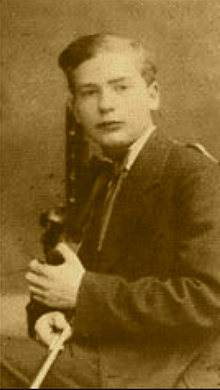Josef Wolfsthal
Josef Wolfsthal (born June 12, 1899 in Vienna , Austria-Hungary ; † February 3, 1931 in Berlin , Germany ), born as Josef Wolfthal , was an Austrian violinist , in Germany also an orchestra conductor and music teacher.
Family and education
Wolfsthal's family came from Galicia and were very musically influenced. His father Lazar and his older brother Max (* 1896) also played the violin. He was initially instructed on this instrument by his father, who was an excellent teacher and also trained Sigmund Feuermann (1900–1952). From the age of ten he received violin lessons from the Hungarian virtuoso Carl Flesch for six years .
He married the pianist and music teacher Olga Szell, b. Band , who was married to George Szell from 1920 to 1926 , and had a daughter with her. Wolfsthal died at the age of 31 of complications from pneumonia; his widow later married Benar Heifetz .
Engagements
Wolfsthal first appeared in public at the age of sixteen. His debut with the Berliner Philharmoniker was on April 7, 1916, when he and Carl Flesch performed the double concerto for two violins in D minor BWV 1043 by Johann Sebastian Bach under the direction of Camillo Hildebrand (1876-1953). Flesch then ordered him a time as an orchestra member in order to instill more discipline in Wolfsthal.
Wolfsthal began in Bremen as the successor to Georg Kulenkampff in the orchestra direction , moved to Stockholm for a short time , until in 1921 he was appointed director of the best German ensemble of the time, the orchestra of the Berlin State Opera Unter den Linden . He was sponsored by Richard Strauss , who often conducted this orchestra. Wolfsthal can be heard in Strauss' first recording of Ein Heldenleben and also in the first recording of Molière's Der Bürger als Edelmann , in which he excels particularly in the tailor's dance . At the age of 26, Wolfsthal became a lecturer at the Berlin University of Music and received a professorship. Among others there was one Kurt Sydow to his students. Wolfsthal also taught Szymon Goldberg and Marianne Liedtke, who later became known as Maria Lidka .
In 1928 he was an active part of the premiere of Karl Weigl's Violin Concerto. Together with Emanuel Feuermann and Paul Hindemith he formed a string trio. After Wolfsthal's early death, his pupil Szymon Goldberg took his place there.
A large number of plays were recorded with Wolfsthal during the 1920s. His style is described as "rhythmically correct with astonishing results", as "very concentrated", "of neat modernity", as "sweet" and " avoiding the portamento technique". The Penguin Guide of Compact Discs describes Wolfsthal's style as "masterful and breathtaking". The reception leads to regret that he passed away much too early.
From 1928 he was Otto Klemperer's representative in the orchestra management of the Berlin Kroll Opera . There he gave the premiere of Hindemith's Chamber Music No. 4, Op. 36. Together with Leonid Kreutzer and Gregor Piatigorsky he formed a trio. When he got the chance to go to the United States with Vladimir Horowitz , his continued lack of discipline put a wrench in this future prospect. During the scheduled audition for Piatigorsky's manager, he suddenly began improvising in the middle of the piece and broke out into boyish laughter at it.
Post fame
On April 18, 2016 took place in the Gasteig cultural center in Munich as part of the lecture series Im Kosmos great violin art. Famous virtuosos and their master classes held an event entitled Carl Flesch and his school: Josef Wolfsthal, Szymon Goldberg, Max Rostal, Roman Totenberg, Henryk Szeryng and others .
Web links
- Josef Wolfsthal: Violin Concerto, D major, opus 61 , by Ludwig van Beethoven , 1929 with the Philharmonic Orchestra Berlin under General Music Director Manfred Gurlitt (39:52 min.), On: bl.uk (The British Library)
- Various recordings by Josef Wolfsthal on: youtube.com
Individual evidence
- ↑ T. Josef Potter: Wolfsthal plays Beethoven and Mozart Concertos ( Memento from April 18, 2016 in the Internet Archive ), on: pristineclassical.com, accessed on June 6, 2020.
- ^ Walter Kolneder / Reinhard G. Pauly: The Amadeus book of the violin: construction, history, and music . Amadeus Press. Portland, Oregon 1998. ISBN 978-1574670387 . P. 467.
- ^ Michael Haas: Forbidden Music: The Jewish Composers Banned by the Nazis . Yale University Press. 2013. ISBN 978-0-300-15431-3 . P. 1903.
- ^ Jonathan Woolf: Ludwig van Beethoven (1770–1827): Violin Concerto in D major Op 61; Wolfgang Amadeus Mozart (1756–1791): Violin Concerto No.5 in A major , from: musicweb-international.com, accessed on April 17, 2016
- ↑ Reinhard J. Brembeck: Dance Tango, Muse! . In: Süddeutsche Zeitung, May 11, 2010, accessed on April 17, 2016
| personal data | |
|---|---|
| SURNAME | Wolfsthal, Josef |
| ALTERNATIVE NAMES | Wolfthal, Josef (maiden name); Wolfstal, Josef; Wolfsthal, Joseph |
| BRIEF DESCRIPTION | Austrian violinist, orchestra leader and music teacher |
| DATE OF BIRTH | June 12, 1899 |
| PLACE OF BIRTH | Vienna , Austria-Hungary |
| DATE OF DEATH | February 3, 1931 |
| Place of death | Berlin , Germany |

